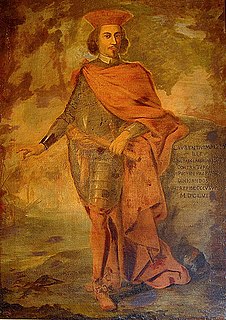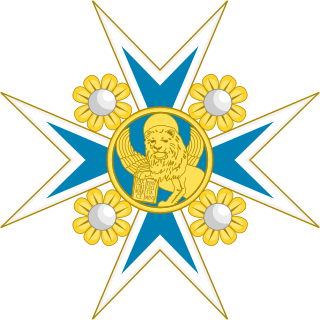Related Research Articles

The Battle of Lepanto was a naval engagement that took place on 7 October 1571 when a fleet of the Holy League, a coalition of Catholic states arranged by Pope Pius V, inflicted a major defeat on the fleet of the Ottoman Empire in the Gulf of Patras. The Ottoman forces were sailing westward from their naval station in Lepanto when they met the fleet of the Holy League which was sailing east from Messina, Sicily. The Spanish Empire and the Venetian Republic were the main powers of the coalition, as the league was largely financed by Philip II of Spain, and Venice was the main contributor of ships.

This indecisive naval battle took place on 8 July 1716 during a Turkish attempt to capture the island of Corfu (Kerkyra), off the west coast of mainland Greece.

The naval Battle of Zonchio took place on four separate days: 12, 20, 22, and 25 August 1499. It was a part of the Ottoman–Venetian War of 1499–1503.

Angelo Emo was a Venetian noble and admiral, mostly known for being the last admiral of the Republic of Venice to lead the Venetian navy to battle. Distinguished for his seamanship since early in his career, he introduced reforms based on the practices of the British Royal Navy, and led raids on the harbours of the Beylik of Tunis in retaliation for corsair attacks on Venetian-flagged shipping.

The Second Ottoman–Venetian War was fought between the Islamic Ottoman Empire and the Republic of Venice for control of the lands that were contested between the two parties in the Aegean Sea, Ionian Sea, and the Adriatic Sea. The war lasted from 1499 to 1503.

Lorenzo Marcello was an Italian admiral from the Republic of Venice.

The Fourth Ottoman–Venetian War, also known as the War of Cyprus was fought between 1570 and 1573. It was waged between the Ottoman Empire and the Republic of Venice, the latter joined by the Holy League, a coalition of Christian states formed under the auspices of the Pope, which included Spain, the Republic of Genoa, the Duchy of Savoy, the Knights Hospitaller, the Grand Duchy of Tuscany, and other Italian states.

Francesco Molin or Francesco Da Molin was the 99th Doge of Venice, reigning from his election on 20 January 1646 until his death. Molin's reign is notable because of Venice's participation in a prolonged war with the Ottoman Empire over Crete; this war was begun during the reign of Molin's predecessor Francesco Erizzo, and dragged on until 1669. To fund the cost of this war, Molin sold access to the Venetian patriciate at a cost of 100,000 ducats per person.

The siege of Corfu took place on 8 July – 21 August 1716, when the Ottoman Empire besieged the city of Corfu, on the namesake island, then held by the Republic of Venice. The siege was part of the Seventh Ottoman–Venetian War, and, coming in the aftermath of the lightning conquest of the Morea by the Ottoman forces in the previous year, was a major success for Venice, representing its last major military success and allowing it to preserve its rule over the Ionian Islands.

The Order of Saint Mark was the sole order of chivalry of the Republic of Venice. It was named in honour of Venice's patron saint, Mark the Evangelist.

The Venetian navy was the navy of the Venetian Republic which played an important role in the history of the republic and the Mediterranean world. It was the premier navy in the Mediterranean Sea for many centuries between the medieval and early modern periods, providing Venice with control and influence over trade and politics far in excess of the republic's size and population. It was one of the first navies to mount gunpowder weapons aboard ships, and through an organised system of naval dockyards, armouries and chandlers was able to continually keep ships at sea and rapidly replace losses. The Venetian Arsenal was one of the greatest concentrations of industrial capacity prior to the Industrial Revolution and responsible for the bulk of the republic's naval power.
Alvise Loredan was a Venetian nobleman of the Loredan family. At a young age he became a galley captain, and served with distinction as a military commander, with a long record of battles against the Ottomans, from the naval expeditions to aid Thessalonica, to the Crusade of Varna, and the opening stages of the Ottoman–Venetian War of 1463–1479, as well as the Wars in Lombardy against the Duchy of Milan. He also served in a number of high government positions, as provincial governor, savio del consiglio, and Procuratore de Supra of Saint Mark's Basilica.

The Captain General of the Sea was the wartime commander-in-chief of the Venetian navy.
The Captain of the Gulf was a senior naval command of the Republic of Venice.
The governatore dei condannati was a senior commander of the navy of the Republic of Venice. The post initially headed the galley squadron manned by convicts and captives rather than free crewmen.
The Capitano delle Navi was a senior commander of the ships of the line of the navy of the Republic of Venice.

The Capitano Straordinario delle Navi was the senior wartime commander of the ships of the line of the navy of the Republic of Venice.
The Provveditore all'Armata or dell'Armata or d'Armata was a senior official and admiral of the Venetian navy. After the establishment of a sailing fleet next to the traditional galley fleet in the late 17th century, he was the most senior squadron admiral of the latter.

The Venetian patriciate was one of the three social bodies into which the society of the Republic of Venice was divided, together with citizens and foreigners. Patrizio was the noble title of the members of the aristocracy ruling the city of Venice and the Republic. The title was abbreviated, in front of the name, by the initials N.H., together with the feminine variant N.D.. Holding the title of a Venetian patrician was a great honour and many European kings and princes, as well as foreign noble families, are known to have asked for and obtained the prestigious title.
The Provveditori all'Armar were officials of the Republic of Venice responsible for the provisioning and equipment of the ships and crews of the Venetian navy.
References
- 1 2 3 4 5 Mocenigo 1935, p. 24.
- 1 2 3 Lane 1973, p. 158.
- ↑ Mocenigo 1935, p. 3.
- 1 2 Mocenigo 1935, p. 25.
- ↑ Mocenigo 1935, pp. 25–26.
- ↑ Mocenigo 1935, pp. 24, 27.
- ↑ Lane 1973, p. 159.
- ↑ Lane 1982, p. 28.
- ↑ Lane 1982, pp. 28–29.
- ↑ Lane 1982, pp. 27–30.
- ↑ Mocenigo 1935, pp. 25, 26.
- 1 2 Mocenigo 1935, p. 26.
- ↑ Mocenigo 1935, pp. 24–25.
- ↑ Mocenigo 1935, p. 4.
